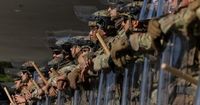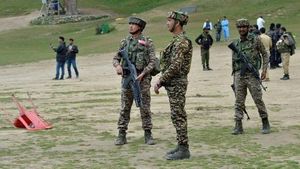The Supreme Court stands on the threshold of a decision that could redefine the boundaries of presidential power and reshape the relationship between the federal government and the states. As of October 24, 2025, the justices are poised to rule on whether a president can unilaterally deploy federal troops on U.S. soil—even over the objections of state governors. The case, Trump v. Illinois, centers on an emergency appeal by the Trump administration after federal judges in Chicago blocked the deployment of National Guard troops to the city.
The government’s argument is sweeping: it contends that courts should not second-guess a president’s decision to deploy troops domestically, claiming this is an area of unreviewable presidential discretion. In their brief, the administration asserts, “there is no reason to believe that courts can, or should, second guess the President’s conclusion” that military force is needed to suppress an emergency. The government insists this case falls within the “heartland of unreviewable presidential discretion.” Even if courts can review such decisions, the administration argues, they must be “highly deferential” to the president’s judgment.
This broad claim of executive power has alarmed legal experts, civil rights advocates, and state officials alike. According to The Los Angeles Times, Georgetown law professor Steve Vladeck called the case a “make-or-break moment for this court,” warning, “For the Supreme Court to issue a ruling that allows the president to send troops into our cities based upon contrived (or even government-provoked) facts ... would be a terrible precedent for the court to set not just for what it would allow President Trump to do now but for even more grossly tyrannical conduct.”
California Attorney General Rob Bonta and Governor Gavin Newsom echoed these concerns in a brief filed with the court. “On June 7, for the first time in our nation’s history, the President invoked [the Militia Act of 1903] to federalize a State’s National Guard over the objections of the State’s Governor,” they wrote. “Since that time, it has become clear that the federal government’s actions in Southern California earlier this summer were just the opening salvo in an effort to transform the role of the military in American society.” They further warned, “At no prior point in our history has the President used the military this way: as his own personal police force, to be deployed for whatever law enforcement missions he deems appropriate. ... What the federal government seeks is a standing army, drawn from state militias, deployed at the direction of the President on a nationwide basis, for civilian law enforcement purposes, for an indefinite period of time.”
Yet, the Trump administration maintains that the National Guard’s role is not to enforce ordinary criminal laws, but to defend federal personnel, property, and functions in the face of ongoing violence—particularly violence stemming from contentious immigration enforcement. U.S. Solicitor General D. John Sauer stated in the government’s emergency appeal, “On October 4, the President determined that the situation in Chicago had become unsustainably dangerous for federal agents, who now risk their lives to carry out basic law enforcement functions.” He described escalating violence against federal officers, stating, “On multiple occasions, federal officers have also been hit and punched by protestors at the Broadview facility. The physical altercations became more significant and the clashes more violent as the size of the crowds swelled throughout September. Rioters have targeted federal officers with fireworks and have thrown bottles, rocks, and tear gas at them. More than 30 [DHS] officers have been injured during the assaults on federal law enforcement at the Broadview facility alone, resulting in multiple hospitalizations.”
Lower courts have not viewed the administration’s claims as sufficient to justify such sweeping federal intervention. In Portland, Judge Karin Immergut, a Trump appointee, described the administration’s depiction of a “war-ravaged” city as “untethered to the facts.” In Chicago, Judge April Perry, a Biden appointee, ruled that “political opposition is not rebellion.” The 9th Circuit Court of Appeals in San Francisco sided with the Trump administration, deferring to the president’s assessment of the threat and allowing National Guard deployment in Portland. But the 7th Circuit in Chicago disagreed, stating, “The facts do not justify the President’s actions in Illinois, even giving substantial deference to his assertions. Federal facilities, including the processing facility in Broadview, have remained open despite regular demonstrations against the administration’s immigration policies. And though federal officers have encountered sporadic disruptions, they have been quickly contained by local, state, and federal authorities.”
At the heart of the legal debate is the question of whether the president is “unable to execute the laws” in a way that justifies federalizing the National Guard under the Militia Act of 1903. The Constitution gives Congress—not the president alone—the power “to provide for calling forth the Militia to execute the laws of the Union, suppress insurrections and repel Invasions.” Since 1903, Congress has said that “the President may call into Federal service members and units of the National Guard of any State in such numbers as he considers necessary” if he faces “danger of invasion by a foreign nation ... danger of a rebellion against the authority of the government of the United States or the president is unable to execute the laws of the United States.”
Conservatives, meanwhile, argue that the president is simply enforcing federal law in the face of local resistance. UC Berkeley law professor John Yoo told The Los Angeles Times, “Portland and Chicago have seen violent protests outside of federal buildings, attacks on ICE and DHS agents, and organized efforts to block the enforcement of immigration law. Although local officials have raised cries of a federal ‘occupation’ and ‘dictatorship,’ the Constitution places on the president the duty to ‘take care that the laws are faithfully executed.’” Yoo also pointed to historical precedents, noting, “Presidents in the past used these same authorities to desegregate southern schools in the 1950s after Brown v. Board of Education and to protect civil rights protesters in the 1960s. Those who cheer those interventions cannot now deny the same constitutional authority when it is exercised by a president they oppose.”
But critics argue that the president’s domestic military deployment powers are far weaker than his powers overseas, as the U.S. Constitution disperses military authority horizontally among the federal branches and vertically between the federal and state governments. The 1878 Posse Comitatus Act forbids the use of the military for domestic law enforcement, and even the Insurrection Act allows presidential use of armed forces only to protect constitutional rights when states are unable to do so. The article in The Atlantic warns that unchecked presidential military deployment risks authoritarianism and undermines democracy, referencing historical abuses of military power and recent coups abroad as cautionary tales.
As the Supreme Court weighs its decision, it must also consider its own precedent. In 1972, the Court stated in Laird v. Tatum: “[T]here is nothing in our Nation’s history or in this Court’s decided cases… that can properly be seen as giving any indication that actual or threatened injury by reason of unlawful activities of the military would go unnoticed or unremedied.”
This ruling, when it comes, will not just determine the outcome in Illinois, Oregon, or California. It will set a precedent for the future of American democracy—testing the balance between executive power, judicial oversight, and the rights of states and citizens.




